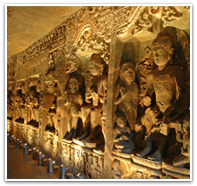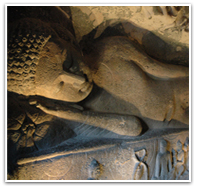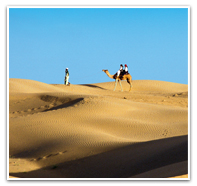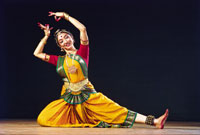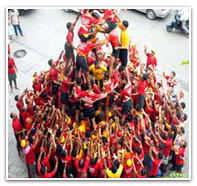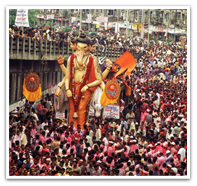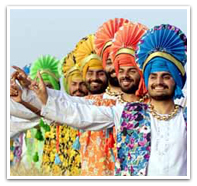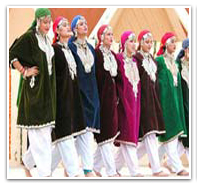India is a vast country with rich and varied cultural heritage. Folk dance and music is the core of the Indian tradition and culture. Some local festivities have today gained so much importance that people from all over the world flock to see them. The Indian government has enhanced the tradition by holding dance and music festivals in world heritage sites.
January is the coldest month in India with a pleasant climate in the southern parts of
India. A number of important cultural festivals take place in the month of January every year. South India hosts many festivals during this pleasant climate. The first and the unique festival is that of the Elephant March. While caparisoned elephants go out in procession, boat races on the backwaters and cultural events lend colour to the festivities. The festival takes place in some of Kerala's major towns – Thrissur,
Alleppey and
Thiruvananthapuram
The Mamallapuram Dance Festival, held in the ancient port city of the Pallavas of
Tamil Nadu, has performances by exponent dancers who perform Bharat Natyam, Kuchipudi, Kathak and Kathakali against the magnificent backdrop of the Pallava rock sculptures. Another delicately carved temple of Pattadakkal, in the southern state of
Karnataka, the ancient capital of the Chalukyas, hosts an annual Pattadakkal dance festival, to celebrate the marvelous heritage. The classical dances performed with the backdrop of the elegantly carved temples gives the performances an aura of worship, rather than jus an art form.
Rajasthan pays tribute to the local animal, the ship of the desert in the month of January. In Bikaner the camels are bedecked and taken up in processions and even a few competitions are held. The festival, known as the
Bikaner festival draws huge crowds.
The month of February is the perhaps the best of the months in the whole year, throughout
India, in the terms of weather. As a result a number of cultural festivals are organized throughout the country during this time of the year. The crisp chilly winters are gone and the advent and smell of spring is in the air. Naturally all over the country the spirits are high during this time of the year and hence many festivals are organized in this month.
Although nearly every state has some or the other cultural extravaganza coming up during this time, there are some which attract tourists from the world over.
The month begins with a 15 day affair with the Surajkund Fair. The Surajkund crafts Mela as it is known all over India is significant due to the place where it is held. Surajkund is in Faridabad near
Delhi. It was an ancient city associated with the great epic Mahabharata. Artisans from all around the country come her to display their handicrafts. The open air fair is based on a theme state every year. The ambiance is picturesque rural bazaar of
India. Along with a vast choice to shop there are cultural shows arranged pertaining to the local art of the theme state. Cuisines form all corners of India are offered here.
The International Yoga Week held in
Rishikesh, a small town in the Uttaranchal state, is to promote the age old tradition of Yoga. This week long event is held at the foothills of the great Himalayas on the banks of River Ganga. Detailed lectures and demonstrations of various forms and arts of Yoga by prominent Yoga masters are held during this week.
Two cities of
Rajasthan come alive and bustle with life in February with the fairs they are host to. The golden city of
Jaisalmer is the host to a three cultural extravaganza called the Desert Festival. Fire dancers swaying to traditional tunes, a turban-tying competition and a Mr. Desert contest are part of the fun of the occasion. Camel rides and folk dances at the sand dunes are an added attraction.
The Nagaur Cattle Fair is equally interesting. This annual cattle fair is believed to be the largest cattle fair in the world. Games and races of animals are the part of this festival.
The much awaited event in
India, at the most coveted historical monument and epitome of Love, is the Taj Mahotsav. During this festival at Agra, the city of Taj Mahal, the best of the Indian cultural aspects are on display. Indian handicrafts travel from all the corners along with their cuisines for this festival. Great performers come from all over India to perform with the majestic backdrop of the Taj. Being a part of the Taj Mahotsav is a unique and unforgettable experience.
During this part of the year the nature is in full bloom. Various types of flowers with vibrant colors are on bloom. The Garden Festival of
Delhi is just that. It is a magnificent display if exotic flowers and plants. Definitely a horticulturists’ delight. Rose Show of
Chandigarh is also held in the same lines with only roses on display and the magnitude is much larger that of Delhi. Held in the Rose Gardens of Chandigarh, this is the biggest Rose show in the country.
Far in the North east festivals welcoming the spring are celebrated by various tribes of the region.
Down South one of the most famous cultural festivals organized during this time of the year is the Elephanta Festival. The Elephanta festival is a week long odyssey of classical dances, vocal and instrumental recitals and small skits and plays that are performed at the Elephanta Islands near
Mumbai. The performers perform with the backdrop of the beautiful rock cut images, artistically developed centuries ago. The audience seats it self under the open sky on the ground. All this builds a perfect ambience for the cultural extravaganza. To reach the place is fascinating as well. Placed on an island, one can reach here only by traveling through the sea.
Near Mumbai the only one of its kind festival is celebrated at the coveted destination of
Goa; the Goa Carnival. The exuberant Goa Carnival is the most famous annual feature of
Goa which has been celebrated since the 18th century. Held in mid- February, just before Lent, the three day event is a time for feasting and drinking with lively processions, floats, the strumming of guitars and graceful dances. The great finale is with the famous Red-and-Black dance held by the Clube Nacional in Panaji.
Another recently started important festival organized further down south is the Deccan Festival, held in the Nizam’s city of
Hyderabad. This annual affair celebrates the soul of the city with the local folk arts of the city. Mushairas are held and qawwalis and ghazals are sung. The pearls and bangles, the local specialties are put on display and so is the ethnic cuisine of
Hyderabad.
The Andaman and the Nicobar Islands are the last tips of the vast Indian Subcontinent. The capital of
Port Blair celebrates the arrival of spring by organizing a big cultural festival comprising of songs, dances and dramas known as the Island Tourism Festival.
The month of March has some of the most exotic cultural festivals taking place at the equally exotic locations. The Khajuraho Festival is a week long affair held at the erotic temples of
Khajuraho. People from all over the world come to watch eminent artists perform under the aegis of the ancient wonderful temples. The sculptures and the stones magnify the performances. The Chandela Kings built the temples as an ode to life and living, the performances are an ode to the beauty within. The cultural festival is an enthralling experience with the ancient stone sculptures forming the background. An annual affair every March, it is a must visit event and a lifetime experience.
The other cultural festival that
Madhya Pradesh hosts is the Tansen Music festival at Gwalior. The Gwalior Gharana has always been one of the most prominent styles of the Hindustani classical music. The lineage that Madhya Pradesh and especially
Gwalior has provided to the Hindustani classical music under the patronage of various Kings is well known. The patriarch of the Hindustani Classical music and one of the nine jewels of the Emperor Akbar’s court, Ustad Tansen lays buried in Gwalior. This place comes alive with distinguished artists’ performances when the place becomes the venue for the annual music festival. What other better way to pay homage to the great singer but performing on his tomb, under his blessings.
The second important festival is the Ellora Festival that takes place at the ancient world heritage site of Ellora in
Maharashtra. These intricately carved caves into the sides of a basaltic hill of the Sahyadri Mountain are the best examples of rock – cut caves in the whole world. It is the meeting point of three faiths, Buddhist, Jain and Hindu and nearly 1500 years old. The cultural programme of Dance and music is performed at the main Kailash Cave which is a lavishly carved cave cut from one rock and is world’s largest monolithic cave.
The Shivaratri Natyanjali Festival celebrated at the Chidambaram temple as a part of worship to the lord during the religious festival of Shivaratri, is a unique mode of worship. Dances and Songs are performed in front of the main deity as a form of worship and this festival goes on for five days.
The Pink city of
Jaipur hosts the Elephant Festival in March. The elephants are decked up to their best and brought here. Various games between the elephants are held during this time.
The Hoysala Mahotsav held in the ancient temples of Belur and Halebid is the reminders of the glory of the Hoysala dynasty which promoted and encouraged dance and music during their rule.
The colourful Mewar Festival in
Rajasthan is celebrated to welcome the spring in the romantic city of
Udaipur. Dances, songs and colours are the essential factors of this festival celebrated in the Mewar region.
Similar festivals which show and encourage the folk culture of the place are held in various places during March. The Pataliputra Mahotsav of
Patna in
Bihar and the Jhansi Mahotsav of
Jhansi belong to the same category.
The beginning of summer season in
India is what the month of April brings in. While it becomes scorching hot in the western and southern parts of India, the northern and the north eastern parts still experience a pleasant weather. Normally it is the time when various regions celebrate their New Years according to their own calendars falling tentatively in the month of April. Thus hardly any cultural festivals take place in April. But the month of May which is the vacation time for educational institutes hence major cultural fairs and festivals take place in May.
The Urs of
Ajmer, though a religious festival has become a fair of great attraction. Urs means Fair and this fair is held at the dargah of the Sufi saint Khwaja Moinuddin Chisti commemorating his union with God. People from all over the world gather here and pay homage to the great saint. Qawwalis and Ghazals are performed in praise of the saint by various artists. People tie threads to the intricately carved windows to fulfill their wishes.
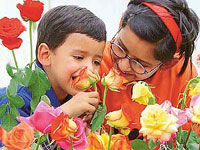
The Northern and the North eastern states come alive with flowers and lush greenery during this time.
Gangtok capital of
Sikkim hosts the International Flower Festival during this time. A great variety of exotic Orchids and rare flowers are on display in April. This spectacular event comes with added attractions of mountaineering, Yak Safari and trekking.
Mostly all the hill stations come up with Summer Festivals in April to attract the visitors. Summer Festivals are held at various hill stations like the
Mount Abu,
Ooty,
Shimla and many more. Various cultural programmes promoting the destination are held during this time of the year.
The month of June is the beginning of the rainy season for the southern part of
India. Hardly any cultural festivals take place during the month of June due to rains and the heat in the northern parts of India. The only attraction of June is the Hemis Festival of
Leh – Ladakh. Hemis is celebrated in the cold desert of Leh and Ladakh in the state of
Jammu and Kashmir. Hemis is the celebration of Birthday of Guru Padmasambhava celebrated in the monastery of the same name. Masked dances are performed and a huge fair is associated with this festival of the northern tip of
India.
The month of July is the full humidity and rains. But one unique festival the
Delhi International Mango Festival is organized in the month of July. As the name suggests the festival is dedicated to mangoes and there are innumerous varieties of mangoes present here. Mangoes from all over the world are on display and also on sale. Various products made of Mangoes are also on sale and various competitions such as the mango eating and the cooking various dishes out of mango are held during the week long festival. It is a mango mania throughout!!!
The Champukulam Boat Race of
Kerala is another unique celebration of life and devotion. It is less known than the other boat races also held in the district of Alappuzha; it is the most ancient and celebrated boat races of
Kerala. Its association with a legend related to Lord Krishna has made the race all the more important for the local people of the area.
Come the month of August and the most auspicious month in the Hindu calendar has arrived. The month of Shravan that falls in August, is dotted with festivals big and small throughout the month. There are so many religious festivals that hardly any cultural occasion takes place during the month of August. The most important cultural event of this month however is the Nehru Trophy Boat Race. This race held in the Alappuzha district of
Kerala is an enthralling experience. About hundred men sit in the huge snake boat and row it in the same rhythm and pace to win the coveted Nehru Trophy. It is an amazing sight and tourists from all around the world are attracted to watch the rhythm of the men while one of them stands and coaxes them to follow the rhythm and win the race.
The month of September brings the famous Ganapati festival of
Maharashtra. To add more attraction to the Festival, the cultural capital of Maharashtra arranges Pune Festival during the same time. The Pune festival is the cultural festival where artists from far and wide come to perform. The festival is full of various classical dances, music and theatre and goes on for 10 days in a row in front of the Lord Ganesh with his blessings. People from all around the world come to attend this festival.
October brings in pleasant weather and festivals galore. People are busy preparing for a host of festivals those come up during the month of October. It is the Marwar Festival celebrated in
Jodhpur Rajasthan that celebrates the Marwar folk lore on the full moon night that falls in October. The folklore of the kings and their valour are sung and hummed in the Maand style of music, specialty of this region during this festival. Another important cultural festival held during the month of October is the celebrated in the small village of Rajgir in Bihar known as the
Rajgir Mahotsav. It is a colourful festival of dance and music which is celebrated at once the capital of the Sakya dynasty and the birth place of Lord Buddha.
The month of November brings in a pleasant climate and high spirits for the people. Many religious as well as cultural festivals take place during the month of November. One of the most famous local festivals which also has a religious association is the Pushkar Mela or the Pushkar Fair.
Pushkar in Rajasthan is a small village which comes alive during the fair in the month of November. It has Starting from the full moon in November this fair goes on for nearly 12 days. The Brahma temple that is found in Pushkar is full of devotees. Trading of cattle, their races and everything related to camels along with several handicraft items is the major attraction of this fair.
Around the same time the world’s largest cattle fair is held in Sonepur village on the bank of the River Ganga in the sate of
Bihar known as the Sonepur Cattle Fair. This month long affair is great display of bedecked cattle from all over the country.
Reminder of the Nawab era of Awadh is brought alive during the
Lucknow Festival. Celebrated in the capital city of
Uttar Pradesh this festival celebrates Lucknow's living culture. This ten day long event witnesses colourful processions, traditional dramas, Kathak along with ghazals, qawwalis and thumri. Other exciting events like the ekka races, kite flying, cock fighting and other traditional village games recreate an atmosphere of the by gone era.
Hampi Festival celebrated in the southern state of
Karnataka in the ruined temples of
Hampi is a unique experience. The dance and the music recitals fill the air to form an ambiguous environment and fascinates all those who come to watch the festival.
December is the coldest month of the year in
India. The southern states are pleasant and the northern states face crisp chilly winters. Along with Christmas and the New Year celebrations December brings in a host of cultural festivals and the most prominent amongst them is the Konark Dance Festival. India is a fascinating country with innumerous Gods and their innumerous temples. But the Sun temple of
Konark is a unique temple with ancient legacy and surrounded by myth and legends. When these ancient temples form a backdrop to the dance performances, they actually come to be a form of worship or prayers by the dancers to the Lord of the temple. The Vishnupur Festival in West Bengal’s
Vishnupur district celebrates the terracotta temples and the silk sarees that it is famous for during this festival.
These are the prime cultural festivals those are held annually in
India. Other than these there is the International Book Fair of
Calcutta and Delhi and Crafts Fair of
Udaipur and
Hyderabad. Nearly every state and the small temples or even the churches and the mosques complete the worship by arranging a huge fair for the occasion.
India truly is a land of festivals and a land of cultural extravaganza.
